FAQ Categories
Primary Pumps
Backup Pumps
Combo Pumps
Standby Batteries
Technical and Installation
Can't find an answer to your question from the above FAQs?
Questions & Answers
Primary Pumps
Why should I use a Basement Watchdog primary sump pump?
All Basement Watchdog primary pumps are built to be durable and reliable. They are engineered with energy efficient PSC motor. This allows the pumps to save you money and help the environment by using less electricity. They are also rated for continuous duty which means they are built to run continuously 24 hours a day, 365 days a year.
back to top
What is included with the Basement Watchdog primary pump?
All Basement Watchdog primary pumps come with the pump itself, controller with dual float switch, and a stainless steel hose clamp.
back to top
What additional items will I need to install my primary pump?
You will also need to supply 1 ½" or 2" rigid PVC pipe to connect to the existing plumbing, a check valve or union, and PVC pipe cleaner with cement.
back to top
Why does my primary pump have two floats?
For added reliability, the float switch has two floats. Both activate the pump. Should one float switch fail to operate, the second float automatically activates the pump. Both floats are covered by a protective cage that prevents debris or other wires from interfering with the movement of the floats.
back to top
How does the dual float switch operate on a primary pump?
The float switch will turn on the pump when the water raises either float, and it will remain running as long as the water is above the float. When the water drops below the float switch, an internal timer in the dual float controller will keep the pump running for additional 10 seconds to empty the rest of the water in the pit.
back to top
Backup Pumps
Why does a Basement Watchdog backup system provide more protection than other brands?
A backup pump with a dead battery, loose cables, or a clogged pump is like having no backup at all. With other brands, you will never know if there is a problem. All Basement Watchdog backup pump systems have unique monitoring systems that sound an alarm when maintenance is needed or when a problem arises. All systems also include the fluid sensor that is used to monitor the battery fluid level.
back to top
Why do I need a backup system?
Everyone who has an AC sump pump should protect their basement with a backup system. At some point the main pump will fail as a result of a power outage, main pump failure, float switch failure or the inability to keep up with the incoming water. A backup pump is an inexpensive insurance policy eliminating the headaches and cost associated with a flooded basement.
back to top
What are the differences between the three Basement Watchdog battery backup systems?
* Based on a 10% duty cycle. Run times may vary based on inflow of water.
** Older versions, before 2014 of the Basement Watchdog Special, Basement Watchdog Big Dog and Basement Watchdog Big Combo systems may not be compatible with maintenance free batteries. Using a maintenance free battery with an older system may cause false alarms. Please call (800) 991-0466 for questions of compatibility.
back to top
What is included with the Basement Watchdog backup system?
All Watchdog systems include the pump, monitoring/charging controller, fluid sensor, float switch, and battery box. You will need to purchase the matching battery and acid. Any additional parts needed for installation, (i.e. check valves and pipe) are listed on the box, brochure and in the manual.
back to top
What additional items will I need to install my backup pump?
You will also need to supply a Basement Watchdog battery, six quarts of 1.265 specific gravity battery acid, 1 ½" rigid PVC pipe and fittings, PVC primer with cement, a union with hose clamps or a "Y" connector and two check valves (depending on the installation method you use), and a surge protector (recommended).
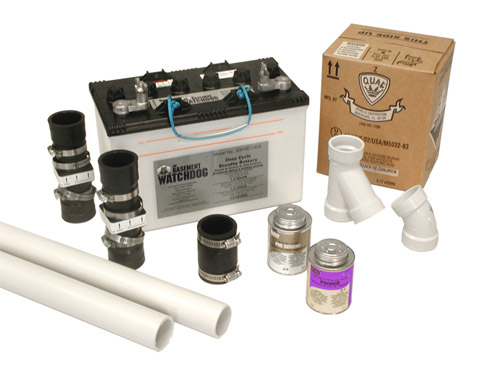
back to top
How easy is it to install a Basement Watchdog backup system?
Installation is easy. All systems come with a detailed manual that includes pictures of the installation process. Installation videos are also available to help guide you.
back to top
Which is the best installation method for my backup system and why?
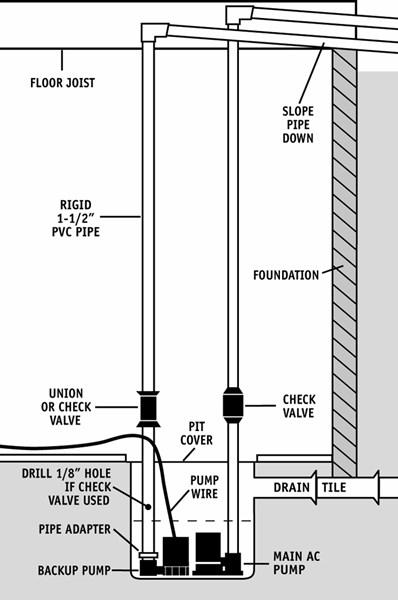 The best installation method is a direct discharge to the outside of the building. With this method, your backup pump is able to operate at full capacity if your main pump is not able to keep up with the incoming water. Also, a bad check valve will not affect the operation of either pump.
The best installation method is a direct discharge to the outside of the building. With this method, your backup pump is able to operate at full capacity if your main pump is not able to keep up with the incoming water. Also, a bad check valve will not affect the operation of either pump.
back to top
If I am connecting to an existing discharge pipe, why do I need two check valves?
Having two working check valves below the "Y" connector is very critical to the operation of the backup pump. For example, if the check valve is bad above the main pump, the water will not get discharged by the backup pump if it has to activate. The water will only go up the "Y" connector and then come down through the main discharge pipe. The check valve above the main pump must be working and installed properly in order for the backup pump to operate.
back to top
How many check valves will I need and why?
If you are connecting to an existing discharge pipe with a "Y" connector, two check valves are required. Both check valves must be installed below the "Y" connector and 1/8" hole must be drilled between the check valve and the backup pump.
Note:Installing a check valve above the "Y" can cause air lock or pressure problems that may result in flooding and is not recommended
If you are adding a second discharge pipe, a check valve is not required. However, a check valve is suggested and will prevent water from flowing back into the pit when the pump shuts off.
back to top
Can I install the backup pump on the bottom of my pit?
We highly recommend placing the backup pump on top of a brick so it is elevated and away from pit debris.
back to top
My pit is too narrow to fit both pumps next to each other. What can I do?
For narrow pits you can mount the backup pump on an "L" bracket above the main pump. You will need to purchase from a hardware store an "L" bracket at least six inches long (preferably one that will not rust), two stainless steel hose clamps, and one stainless steel screw (#8-32 x ¾") with a matching washer & nut (refer to our manual for instructions).
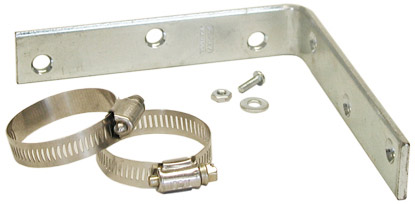
Consider one of our combination systems. These systems come pre-assembled with check valves, a "Y" connector and both primary and backup pumps. They feature a compact design that can fit most narrow pits.
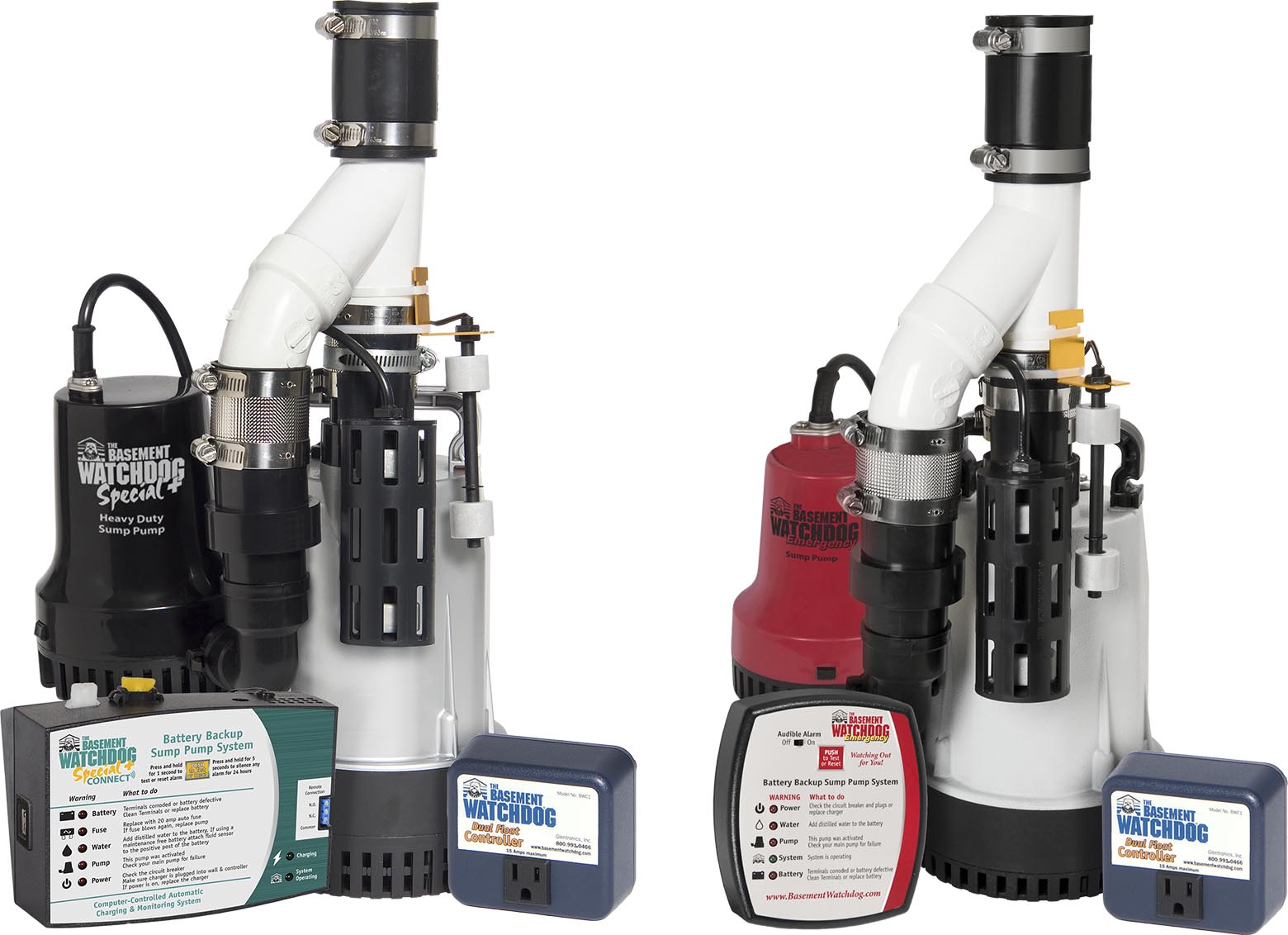
back to top
Is there a way to be alerted when I am not home about issues with my backup system and battery?
The Basement Watchdog Connected Pump – Multi-Technology Solution
It is now possible to remotely monitor and receive notifications on the status of your Basement Watchdog Backup or Combo System. Our comprehensive approach gives you the choice and flexibility not found in other systems.
There are 2 ways to connect:
- Basement Watchdog CONNECT® and the USB Data port – plug your Basement Watchdog Backup or Combo system in to one of the Basement � Watchdog CONNECT® Module that either links to your home Wi-Fi. Receive texts, email or in App notifications
- Remote Terminal – pair of dry contacts can connect to existing security systems, auto dialers or other external devices
Basement Watchdog CONNECT® with USB Data Port:
- Connect the Backup or Combo System to a Basement Watchdog CONNECT® Module via USB cable
- The Basement Watchdog CONNECT® module now acts a gateway to the internet
- WiFi module currently available:
- Conveys which alert has been activated or what maintenance might be needed
Basement Watchdog CONNECT® is currently available on the following systems:



Remote Terminal:
- Connects to optional Basement Watchdog CONNECT® WiFi Module
- Connects to a home security system, auto dialer or other device with dry contacts
- Allows older model Basement Watchdog systems to alert remotely
back to top
Why does my backup pump have two floats?
For added reliability, the float switch has two floats. Both perform the same operation, activate the pump. Should one float switch fail to operate, the second float automatically activates the pump.
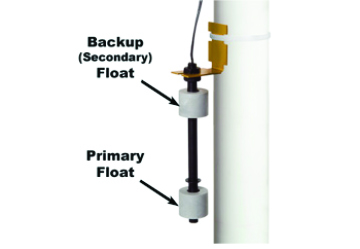
back to top
How does the dual float switch operate on a backup pump?
The float switch will turn on the pump when the water raises either float, and it will remain running as long as the water is above the float. When the water drops below the float switch, an internal timer in the control unit will keep the pump running an additional 25-60 seconds to empty the sump pit. The actual additional run time will depend on the backup system.

back to top
Do I need to plug my backup system into a surge protector?
Power surges and power spikes can occur at anytime. Unfortunately they can damage the electronics inside the control unit of your backup system. Protect your backup system with a surge protector which is a device that suppresses power surges. A surge protector can be purchased at any electronics or hardware store. They are rated in joules. At least 1500 joules is recommended for any of our backup systems. We do not suggest plugging the primary pump into a surge protector.
back to top
Can I use a maintenance-free battery on your backup systems?
A maintenance-free battery can be used on:
* Based on a 10% duty cycle. Run times may vary based on inflow of water.
** Older versions, before 2014 of the Basement Watchdog Special, Basement Watchdog Big Dog and Basement Watchdog Big Combo systems may not be compatible with maintenance free batteries. Using a maintenance free battery with an older system may cause false alarms. Please call us at (800) 991-0466 opt. 3 for questions about compatibility.
back to top
Can I connect two batteries to my backup system to provide longer run time?
Only if they are used on the Big Dog CONNECT®, Special Plus, or Special CONNECT® systems. To do this, the two batteries must be connected in parallel (positive) to (positive) and (negative) to (negative). A special cable can be ordered by calling Glentronics at 800-991-0466 option 3. It is highly recommended to use batteries that are the same size and age. Connecting two batteries in parallel will double your pumping time during a power outage. It is also recommended to purchase a battery box for the battery. This can be ordered from Glentronics as well.
back to top
Where can I get a replacement fuse for my backup system?
A replacement fuse can be purchased either:
- Directly from our customer service
- Toll Free: (800) 991-0466, Option 3
Hours: 9AM - 5PM CST; Monday – Friday
- E-mail: Mail@Glentronics.com
We strive to answer all e-mails within one business day, however during weather events it may take a little longer.
- Otherwise, you may purchase the DC fuse from any auto parts or hardware store and the AC fuse from any hardware store.from any hardware store. The rating of the fuse is specific to the model unit. Please see the fuse or the back of your backup control box for the fuse rating.
back to top
Combo Pumps
Why do I need a combination system?
All of the Basement Watchdog combination systems come pre-assembled for easy installation and offer primary and battery backup pump capabilities. They also have a compact design that fits into pits with diameters as small as 12 inches.
back to top
What is included with the Basement Watchdog combination system?
All Basement Watchdog combination systems come with a primary pump with dual float switch, backup pump with a mounting bracket, control unit for the backup pump with a dual float switch and battery fluid sensor, transformer, a rubber union, battery cap, and extra zip ties to secure wires.
back to top
What additional items will I need to install my combination system?
You will also need to supply a 12V standby battery. All Basement Watchdog standby batteries are specifically designed to work with our battery backup and combination systems. They are the only batteries that will accommodate the battery fluid sensor. You will also need to supply six quarts of 1.265 specific gravity battery acid (30HDC140S and 24EP6 batteries only). For some installations you may also need additional items: 1 ½" rigid PVC pipe, 1 ½" PVC pipe connector or 1 ½" rubber union, and PVC pipe cleaner with cement.
back to top
How easy is it to install a Basement Watchdog combination system?
For convenience, both pumps have been pre-assembled for easy installation with a "Y" connector and two check valves. All combination systems come with a detailed manual that includes pictures of the installation process. Easy to follow videos are also available to help guide you.
back to top
I already have a check valve in my plumbing setup. Can I leave it?
All Basement Watchdog combination systems come with two built in check valves. It is highly recommended to remove the existing check valve. Not only will it reduce the pumping capacity of both pumps but it can cause pressure problems or air lock.
back to top
Is there a way to be alerted when I am not home about issues with my pump and battery?
The Basement Watchdog Connected Pump – Multi-Technology Solution
It is now possible to remotely monitor and receive notifications on the status of your Basement Watchdog Backup or Combo System. Our comprehensive approach gives you the choice and flexibility not found in other systems.
There are 2 ways to connect:
- Basement Watchdog CONNECT® and the USB Data port – plug your Basement Watchdog Backup or Combo system in to the Basement � Watchdog CONNECT® WiFi Module that links to your home Wi-Fi. Receive texts, email or in App notifications
- Remote Terminal – pair of dry contacts can connect to existing security systems, auto dialers or other external devices
Basement Watchdog CONNECT® with USB Data Port:
- Connect the Backup or Combo System to a Basement Watchdog CONNECT® Module via USB cable
- The Basement Watchdog CONNECT® module now acts a gateway to the internet
- Module currently available:
- Basement Watchdog WiFi Module links to a Wi-Fi router and will send email, texts or in App notifications with the Basement Watchdog App
- Conveys which alert has been activated or what maintenance might be needed
Basement Watchdog CONNECT® is currently available on the following systems:



Remote Terminal:
- Connects to optional Basement Watchdog CONNECT® WiFi Module
- Connects to a home security system, auto dialer or other device with dry contacts
- Allows older model Basement Watchdog systems to alert remotely
back to top
Why does each float switch have two floats on the combination system?
For added reliability, the float switch has two floats. Should one float switch fail to operate, the second float automatically activates the pump. This means that the combination system features a total of four float switches for extra reliability. The primary pump's float switch features a protective cage that prevents debris or other wires from interfering with the movement of the floats.

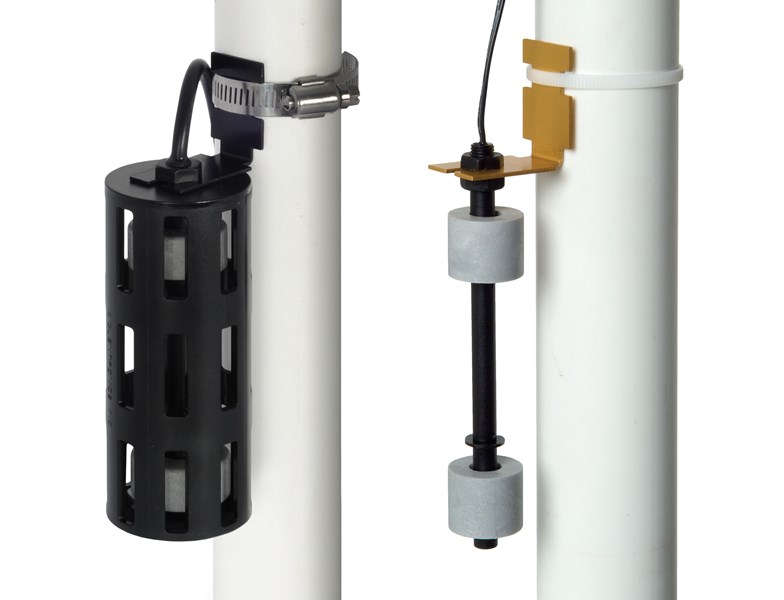
back to top
How do the dual float switches operate on the combination system?
The float switch will turn on the pump when the water raises either float, and it will remain running as long as the water is above the float. When the water drops below the float switch, an internal timer in the control unit will keep the pump running to empty the rest of the water in the pit. The backup control unit will run the pump for additional 25-60 seconds. The dual float controller for the primary pump will keep the pump running for additional 10 seconds.
back to top
Do I need to plug my combo system into a surge protector?
Power surges and power spikes can occur at anytime. Unfortunately they can damage the electronics inside the control unit of your backup system. Protect your backup system with a surge protector which is a device that suppresses power surges. A surge protector can be purchased at any electronics or hardware store. They are rated in joules. At least 1500 joules is recommended for any of our backup systems. We do not suggest plugging the primary pump into a surge protector.
back to top
Can I use a maintenance-free battery on your combo systems?
A maintenance-free battery can be used on:
| |
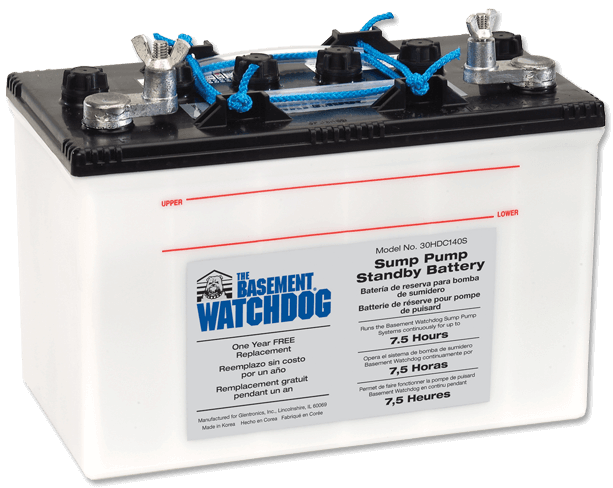
|
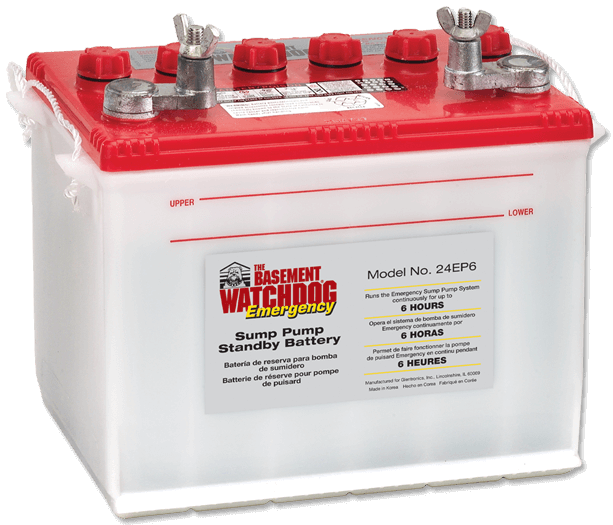
|
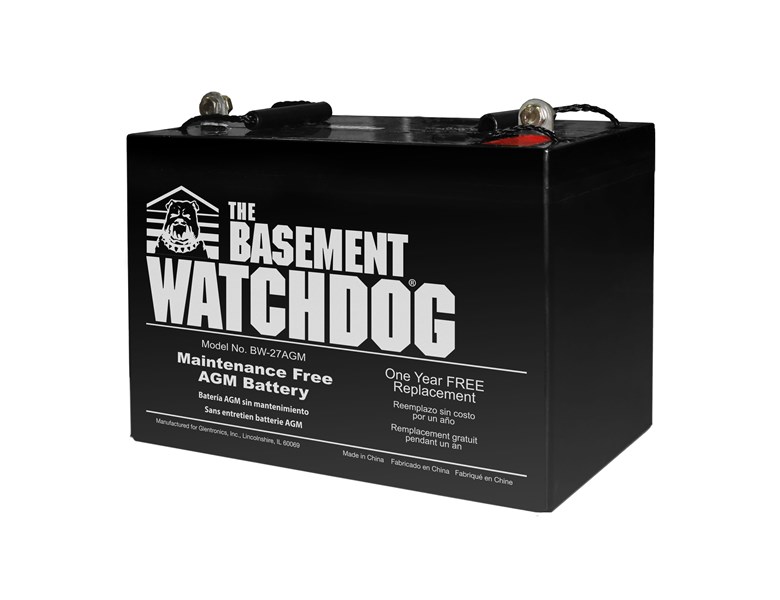
|
| COMBO SYSTEM RUN TIME* |
| Big Combo |
60 hours |
Not recommended |
48 hours |
| Combo |
100 hours |
50 hours |
80 hours |
* Based on a 10% duty cycle. Run times may vary based on inflow of water.
** Older versions, before 2014 of the Basement Watchdog Special, Basement Watchdog Big Dog and Basement Watchdog Big Combo systems may not be compatible with maintenance free batteries. Using a maintenance free battery with an older system may cause false alarms. Please call us at (800) 991-0466 opt. 3 for questions about compatibility.
back to top
Can I connect two batteries to my combo system to provide longer run time?
This can be done only on the Basement Watchdog Big Combo. To do this, the two batteries must be connected in parallel (positive) to (positive) and (negative) to (negative). A special cable can be ordered by calling Glentronics at 800-991-0466 option 3. It is highly recommended to use batteries that are the same size and age. Connecting two batteries in parallel will double your pumping time during a power outage. It is also recommended to purchase a battery box for the battery. This can be ordered from Glentronics as well.
back to top
Standby Batteries
Why use a Basement Watchdog battery?
The Basement Watchdog batteries have been designed specifically to work with the Basement Watchdog backup systems and combo systems. The wet cell standby batteries are the only batteries that accommodate the fluid sensor, which is a very important feature for maintaining battery performance. They are constructed to provide longer pumping times than most other batteries, and to last longer than other brands.
back to top
Do I have to fill your battery with acid?
The Basement Watchdog Maintenance Free/AGM standby batteries don't require any acid. The Basement Watchdog Wet Cell standby batteries are sold dry and have to be activated with acid. This allows us to make sure that our customers get the most out of the battery. The life of the battery starts when it is filled with acid.
back to top
How often should I add water to my wet-cell battery?
For the Basement Watchdog Battery Backup Systems, water should be added every 4-6 months. Although, as the battery ages this time may be shortened. If you are adding water every few weeks, the battery may need replacing. Have your battery load tested at your local automobile service station. If your battery tests fine, your system may be overcharging the battery, and needs to be sent in for service.
back to top
How do I dispose of the extra battery acid?
The acid can be neutralized with baking soda or can be taken to any place that has a HazMat (Hazardous materials) pick up.
back to top
I have used the entire pack of acid and I don't have enough acid to fill the last cell. What can I do?
Make sure you have no more acid left in the pack. If the pack is empty, more acid may need to be purchased. You can purchase 1 quart of 1.265 specific gravity acid from a battery store.
If the first five cells are full, you can use a turkey baster, or other similar instrument, and even out the cells making sure that the plates are fully covered. You may then use distilled water and top off all six cells.
Note: Thoroughly wash the turkey baster before use with food
back to top
Why does my battery smell like rotten eggs when I fill it with acid?
The smell of rotten eggs is common when the battery is new. When you fill the battery with acid, the initial reaction between the plates and the acid produces sulfur dioxide. It smells like rotten eggs, but is harmless and will dissipate within a short time.
back to top
Why is the "battery fluid low" alarm on even after the cells are filled to the proper level?
Be sure to add fluid to all six battery cells, and then place the sensor rod in the correct cell. Acid is only added the first time to activate the battery. Distilled water is used all other times. The sensor rod should be in the second cell from the positive ( ) terminal of the battery. If it is in any other cell, it is not measuring correctly. Make sure all 2 ½" of the sensor is inserted in the pre-drilled hole in the battery cap, or in the hole in the battery case, depending on which battery you own. An arrow on the top label points to the correct location. If you are using a different brand battery, the fluid sensor must be attached to the positive ( ) terminal of the battery.
Note: You should never drill a hole into the battery yourself
back to top
How long do I have to charge the battery after I add the acid?
By adding the acid you are activating the battery. After adding the acid, the battery will be charged 80% to 90% within 15 minutes. It can be used immediately, and the system will complete the charging process once the charger is plugged into the wall.
back to top
What do I use the yellow cap for?
The yellow cap is used with Basement Watchdog Wet Cell standby batteries to accommodate the fluid sensor. It is to be placed in the second cell from the positive post and the sensor is inserted into the off center hole in the cap. ***Please note that some Basement Watchdog batteries have only 2 long rectangular caps with a hole already present in the top of the battery case. If you have this battery, the yellow cap will not be needed but keep it in case you need it in the future. If you have misplaced your yellow cap please call Glentronics at 800-991-0466, option 3 for a free replacement.
back to top
I am using a maintenance-free battery. What do I do with the fluid sensor rod?
To permanently disable the water fluid low alarm, attached the fluid sensor rod to the positive terminal of the battery. This can be done by tightening down the wing nut on top of the positive terminal and the fluid sensor.
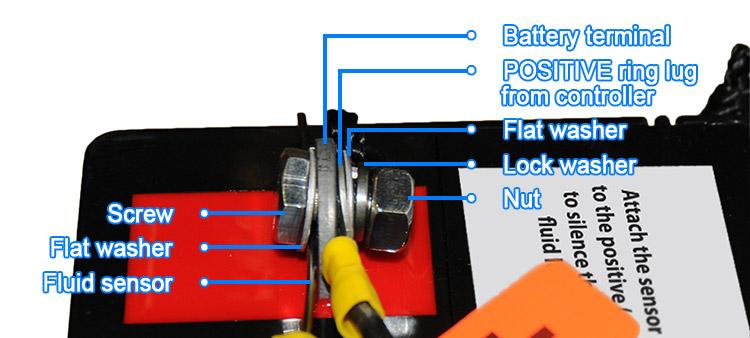
back to top
Explain "clean battery terminals".
Over time, corrosion forms on the terminals that connect the battery to the unit. This corrosion is common, but if it is not cleaned off, the battery will not charge properly. The Watchdog has the ability to detect this corrosion and will sound an alarm when it needs cleaning. Use a stiff wire brush or sand-paper to clean the battery terminal posts, the rings on the end of the battery cable, and the wing nuts until they are shiny. See the manual for detailed instructions and safety precautions.
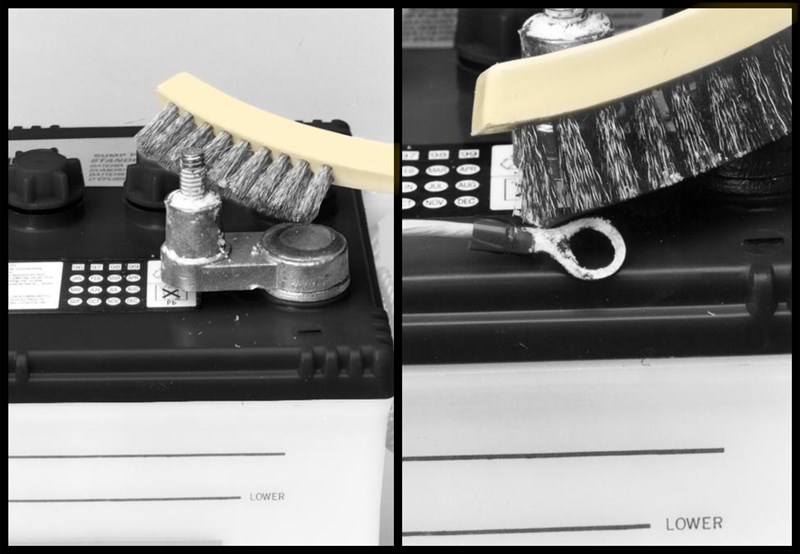
back to top
I just connected a new battery to the system and the controller is showing a "battery is low" message.
Give a new battery approximately 24 hours to come to a full charge. If the battery light is still on after 24 hours, please contact out service department for additional troubleshooting tips. They can be reached at 800-991-0466, option 3.
back to top
How long does it take to fully charge a battery after it has been used extensively?
It depends on the size of the battery and the sump pump system that is doing the charging. The Big Dog system has a powerful 20-amp smart charger that will charge a discharged battery in approximately 6 hours. The charger on the Basement Watchdog Special is a smaller 1.6 amp smart charger and may take 3 days to fully recharge. While the Emergency system is a small .4 amp trickle charger and can take several days to recharge a battery. Alternately, you could take the battery to service station for a quick charge, or hook the battery up to an automotive charger if you have one. Be sure to disconnect the control unit from the battery if you are using an automotive charger. If you don't, the control unit may be damaged.
back to top
Technical and Installation
Is there a way to be alerted when I am not home about issues with my pump and battery?
ENABLING THE CONSUMER TO BE ALERTED REMOTELY
The Basement Watchdog Connected Pump – Multi-Technology Solution
It is now possible to remotely monitor and receive notifications on the status of your Basement Watchdog Backup or Combo System. Our comprehensive approach gives you the choice and flexibility not found in other systems.
There are 2 ways to connect:
- Basement Watchdog CONNECT® and the USB Data port – plug your Basement Watchdog Backup or Combo system in to the Basement � Watchdog CONNECT® WiFi Module that links to your home Wi-Fi. Receive texts, email or in App notifications
- Remote Terminal – pair of dry contacts can connect to existing security systems, auto dialers or other external devices
Basement Watchdog CONNECT® with USB Data Port:
- Connect the Backup or Combo System to a Basement Watchdog CONNECT® Module via USB cable
- The Basement Watchdog CONNECT® module now acts a gateway to the internet
- Currently available:
- Basement Watchdog WiFi Module links to a Wi-Fi router and will send email, texts or in App notifications with the Basement Watchdog App
Basement Watchdog CONNECT® is currently available on the following systems:



Remote Terminal:
- Connects to optional Basement Watchdog CONNECT® WiFi Module
- Connects to a home security system, auto dialer or other device with dry contacts
- Allows older model Basement Watchdog systems to alert remotely
back to top
The pump is running continuously. What do I do?
Make sure the float switch is properly mounted with the round floats hanging below the metal bracket. Make sure the bracket is straight, not on an angle. Once the float switch is activated, it starts a timer that will run the pump about 25-60 seconds before it shuts off. This way it will empty all the water in the sump pit. The pump will not be damaged if it keeps running after all the water has been discharged from the sump.

back to top
If no water is being pumped out of the sump pit, what's wrong?
The first thing to check is the installation of the pump. Make sure the pump is plugged into the back of the control unit. Second, if a check valve has been used in the installation, make sure it is installed correctly. If it is upside down, no water can pass through it. Make sure the arrow on the check valve is pointing up. If you are using 2 check valves, both check valves must be installed properly and below the "Y" connector. It is very important to check the operation of the check valve above the main pump. Finally, make sure a 1/8" hole has been drilled in the PVC pipe about 3" above the pump. You can check our troubleshooting guides for further help.
back to top
How do I silence the alarm on my system?
On the Big Dog, Special, and Big Combo systems press and hold the reset button continuously for approximately 5 seconds to silence the alarm for 24 hours. On the Basement Watchdog Emergency slide the switch, located on the front panel, to the left. Please note that not all alarms can be silenced if immediate attention is required. Please refer to your instruction manual for details.
back to top
Why does my carbon monoxide detector alarm go off near the battery?
A carbon monoxide detector cannot differentiate between sulfur dioxide and carbon monoxide. Sulfur dioxide, which is emitted by the battery, is not harmful. Move the carbon monoxide detector a little further away from the battery.
back to top
How many check valves will I need and why?
If you are not connecting to an existing discharge pipe, a check valve is not required. However, a check valve will prevent water from flowing back into the pit when the pump has stopped. If you are connecting to an existing discharge pipe, two check valves are required. Both must be installed below the "Y" connector and 1/8" hole must be drilled below the check valve and the backup pump.
back to top
If I am connecting to an existing discharge pipe, why do I need two check valves?
Having two working check valves below the "Y" connector is very critical to the operation of the backup pump. For example, if the check valve is bad above the main pump, the water will not get discharged by the backup pump if it has to activate. The water will only go up the "Y" connector and then come down through the main discharge pipe. The check valve above the main pump must be working and installed properly in order for the backup pump to operate.
back to top
My check valve is making a loud clunking sound when the pump stops. What can I do?
Most check valves will make a sound when they close. We suggest the Basement Watchdog Klunkless check valve. It features a silencing air chamber that absorbs the sound that normally occurs after a pump shuts off. Otherwise, make sure your discharge assembly is attached solidly, and the pump is resting firmly on the bottom of the pit.
back to top
Why drill the 1/8" hole in the PVC pipe?
The purpose of the 1/8" hole is to prevent the pump from being air locked. A pump that is air locked cannot pump water. This hole should be drilled approximately 3" above the pump at a 45° angle directed downward, so the water will flow back into the sump pit. When the pump is running, water should be shooting out of the hole. Some main pumps may require the 1/8" hole as well. Check with the manufacturer of your main pump if it is required, or watch our installation videos.
back to top
My pit is too narrow to fit both pumps next to each other. What can I do?
For narrow pits you can mount the backup pump on an "L" bracket above the main pump. You will need to purchase from a hardware store an "L" bracket at least six inches long (preferably one that will not rust), two stainless steel hose clamps, and one stainless steel screw (#8-32 x 3/4") with a matching washer & nut (refer to our manual for instructions).

Consider one of our combination systems. These systems come preassembled with both check valves, a "Y" connector and both pumps. They feature a compact design that can fit most narrow pits.

back to top
How does the dual float switch operate on the backup and combination systems?
The float switch will turn on the pump when the water raises either float, and it will remain running as long as the water is above the float. When the water drops below the float switch, an internal timer in the control unit will keep the pump running an additional 25-60 seconds to empty the sump pit. The actual additional run time will depend on the backup system.


back to top
Why does my float switch have two floats?
For added reliability, the float switch has two floats. Both perform the same operation, activate the pump. Should one float switch fail to operate, the second float automatically activates the pump.

back to top
Where do I install the dual float switch?
The float switch should be mounted about six inches above the water level line in the sump pit. Attach the float switch very securely to the discharge pipe with a plastic wire tie.
back to top
Which is the best installation method and why?
 The best installation method is a direct discharge to the outside of the building. With this method, your backup pump is able to operate at full capacity if your main pump is not able to keep up with the incoming water. Also, a bad check valve will not affect the operation of either pump.
The best installation method is a direct discharge to the outside of the building. With this method, your backup pump is able to operate at full capacity if your main pump is not able to keep up with the incoming water. Also, a bad check valve will not affect the operation of either pump.
back to top
Do I need to plug my system into a surge protector?
Power surges and power spikes can occur at anytime. Unfortunately they can damage the electronics inside the control unit of your backup or combination system. Protect your backup or combo system with a surge protector, a device that suppresses power surges, which can be purchased at any electronics or hardware store. Surge protectors are rated in joules—at least 1500 joules is recommended for all Basement Watchdog backup systems and also for the backup pump in our combination systems. Do not plug the primary pump into a surge protector.
back to top
Can't find an answer to your question from the above FAQs?